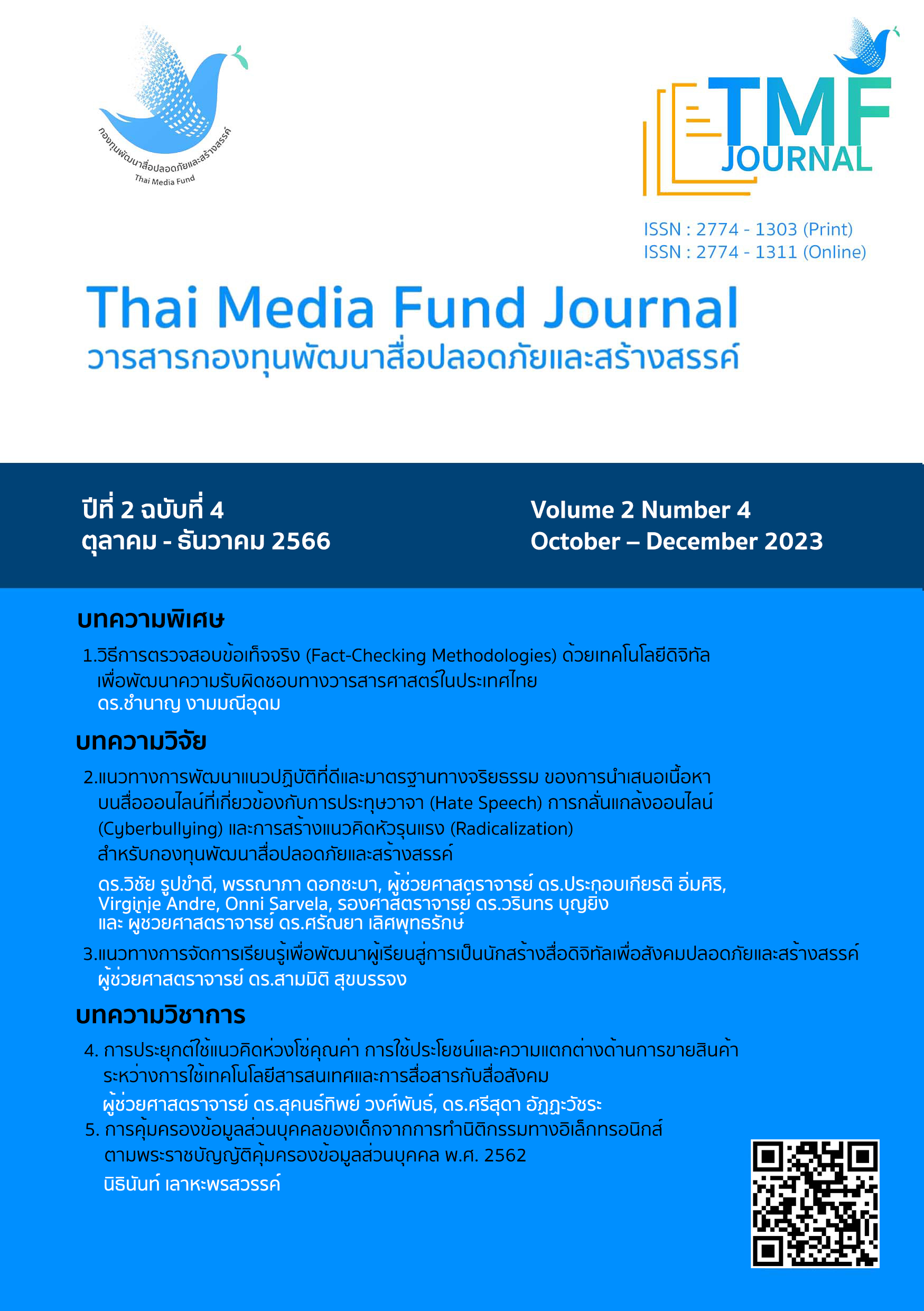การประยุกต์ใช้แนวคิดห่วงโซ่คุณค่า การใช้ประโยชน์และความแตกต่างด้านการขายสินค้าระหว่างการใช้เทคโนโลยีสารสนเทศและการสื่อสารกับสื่อสังคม
Main Article Content
บทคัดย่อ
แนวคิดห่วงโซ่คุณค่ามุ่งเน้นการพัฒนาและปรับปรุงกระบวนการดำเนินการธุรกิจเพื่อสร้างความพึงพอใจสูงสุดให้กับลูกค้า สามารถนำมาประยุกต์ในการใช้เทคโนโลยีสารสนเทศและการสื่อสาร และสื่อสังคมเพื่อการขายสินค้าและให้บริการ เริ่มตั้งแต่ต้นน้ำ กลางน้ำ และปลายน้ำ แต่อย่างไรก็ตาม พบว่า ทั้งการใช้เทคโนโลยีสารสนเทศและการสื่อสาร และสื่อสังคมมีความแตกต่างด้านการขายสินค้าหลายประการ ได้แก่ ลักษณะการสื่อสาร กลุ่มเป้าหมาย และระยะเวลาในการสื่อสาร รวมไปถึงการใช้ประโยชน์ด้านการขายสินค้าจากการใช้เทคโนโลยีสารสนเทศและการสื่อสารกับสื่อสังคมนั้นมีแง่มุมที่แตกต่างกัน ตัวอย่างเช่น การใช้เทคโนโลยีสารสนเทศและการสื่อสารมุ่งเน้นไปที่การพัฒนาเว็บไซต์พาณิชย์อิเล็กทรอนิกส์เพื่อสร้างช่องทางการขายสินค้าที่มีประสิทธิภาพ ในขณะที่สื่อสังคมมุ่งเน้นการสร้างเนื้อหาที่สนุกและน่าสนใจเพื่อให้ลูกค้าตัดสินใจซื้อสินค้าหรือบริการได้ง่ายและรวดเร็วขึ้น
คำสำคัญ: ห่วงโซ่คุณค่า, เทคโนโลยีสารสนเทศและการสื่อสาร, สื่อสังคม, การขายสินค้า
Article Details

อนุญาตภายใต้เงื่อนไข Creative Commons Attribution-NonCommercial-NoDerivatives 4.0 International License.
เอกสารอ้างอิง
Anupong, K. (2021). Study of online consumer behavior on Shopee. WMS Journal of Management, 10(1), 59-67.
Boyd, D., & Ellison, N. (2007). Social network sites: Definition, history, and scholarship. Journal of Computer-Mediated Communication, 13(1), 210-230.
Burt, J., & Sparks, A. (2021). How TikTok is revolutionizing
E-commerce: A new era of social commerce. Harvard Business Review. Retrieved from: https://hbr.org/2021/06/how-tiktok-is-revolutionizing-e-commerce
Chaffey, D., & Ellis-Chadwick, F. (2019). Digital marketing: strategy, implementation and practice (7th ed.). Pearson.
Chin, W. W. (2018). The partial least squares approach to structural equation modeling. In Marcoulides, G. A., & Wang, P. (Eds.), Handbook of Structural Equation Modeling (pp. 47-82). Chapman and Hall/ CRC.
Cohen, W. (2021). The ultimate guide to selling on Lazada: Ecommerce platforms. Retrieved from: https://ecommerce-platforms.com/ecommerce-selling-advice/ultimate-guide-selling-lazada
Collier, L. (2022). The complete guide to Facebook ads. WebFX. Retrieved from: https://www.webfx.com/social-media/facebook-ads-guide.html
Davis, F. D. (1989). Perceived usefulness, perceived ease of use, and user acceptance of information technology. MIS Quarterly, 13(3), 319-340.
Jain, A. K. (2021). Facebook marketing: A step-by-step guide to building your brand and your business on the world's largest social network (6th ed.). Wiley.
Kaplan, A. M., & Haenlein, M. (2010). Users of the world, unite! the challenges and opportunities of social media. Business Horizons, 53(1), 59-68.
Kietzmann, J. H., Hermkens, K., McCarthy, I. P., & Silvestre, B. S. (2011). Social media? get serious! understanding the functional building blocks of social media. Business Horizons, 54(3), 241-251.
LaRose, R., & Steinfield, C. (2013). The information and communication technology active aging (ICTAA) program. International Journal of Communication, 7, 3092-3111.
Laudon, K. C., & Laudon, J. P. (2020). Management information systems: Managing the digital firm (16th ed.). Pearson.
Laudon, K. C., & Traver, C. G. (2016). E-commerce 2016: Business, technology, society (12th ed.). Pearson.
Lee, T. T., & Kim, Y. K. (2021). A comparative study of Shopee and Lazada E-commerce in Southeast Asia. International Journal of Digital Marketing, 3(2), 124-132.
Lee, Y., & Kozar, K. A. (2012). Understanding of consumer e-learning acceptance: An application of the extended technology acceptance model. Computers & Education, 59(3),
-1056.
Mascarenhas, O. A., Kesavan, R., & Bernacchi, M. (2004). Customer value-chain involvement for co--creating customer delight. Journal of Consumer Marketing, 21(7), 486-496.
Meyer, C., & Schwager, A. (2007). Understanding customer experience. Harvard Business Review, 85(2), 116-126.
Morley, D. A., & Cortada, J. W. (eds.) (2000). the information society: An international perspective. Center for International Studies, Princeton University Press.
Naim, M. F., Othman, M. S., Idris, N. B., & Aziz, N. A. A. (2019). Predicting customer behavior using data analytics and machine learning techniques. In Proceedings of the International Conference on Industrial Engineering and Operations Management (pp. 1377-1387).
O'Brien, J. A., & Marakas, G. M. (2018). Management information systems (10th ed.). McGraw-Hill.
Pansari, A., & Kumar, V. (2017). Customer engagement: The construct, antecedents, and consequences. Journal of the Academy of Marketing Science, 45(3), 294-311.
Porter, M. E. (1985). Competitive advantage: Creating and sustaining superior performance. Free Press.
Porter, M. E. (1998). Competitive advantage: Creating and sustaining superior performance. New York: Free Press.
Prasertpitoon, C., & Zupasit, N. (2022). Pop culture and top online issues in December 2022. Thai Media Fund Journal, 2(1), 41-64.
Rheingold, H. (2000). The virtual community: Homesteading on the electronic frontier. MIT press.
Roy, A. (2022). Patterns of participation in political discourse among
social media users. Changing Landscape of News
Media & Entertainment, 59.
Schiffman, L. G., & Kanuk, L. L. (2018). Consumer behavior (11th ed.). Pearson.
Smith, A. N., Fischer, E., & Yongjian, C. (2012). How does brand-related user-generated content differ across YouTube, Facebook, and Twitter? Journal of Interactive Marketing, 26(2), 102-113.
Smith, L. (2021). How to use Facebook marketplace: The ultimate guide. Oberlo. Retrieved from: https://www.oberlo.com/blog/facebook-marketplace
Soegoto, M. (2022). Competitive strategies of Lazada E-commerce in Southeast Asia. International Journal of Scientific & Technology Research, 11(3), 314-319.
Stephen, A. T., & Galak, J. (2012). The effects of traditional and social earned media on sales: A study of a microlending marketplace. Journal of Marketing Research, 49(5), 624-639.
Turban, E., Rainer, R. K., & Potter, R. E. (2020). Information technology for management: On-demand strategies for performance, growth, and sustainability (12th ed.). Wiley.
Venkatesh, V., & Davis, F. D. (2000). A theoretical extension of the technology acceptance model: Four longitudinal field studies. Management Science, 46(2), 186-204.


